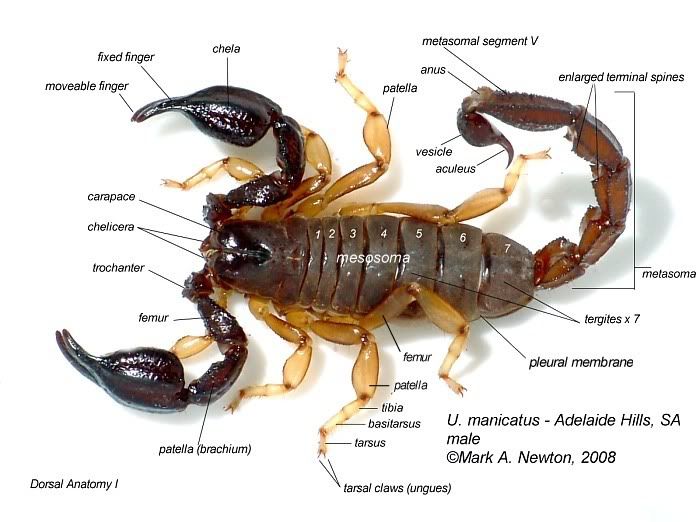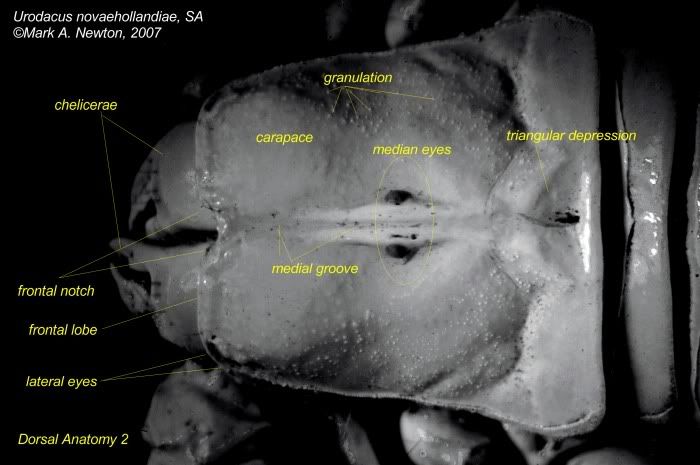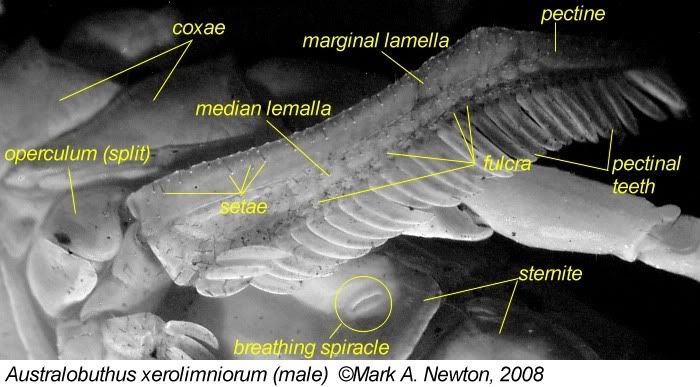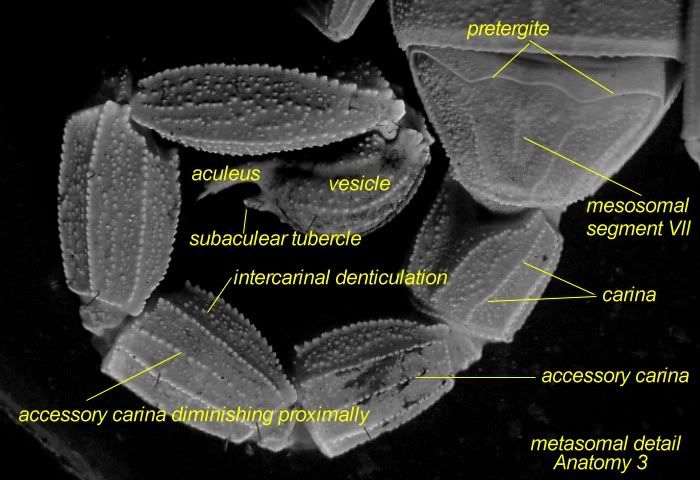Words & Terms to Know About Scorpion Keeping
Aculus - the sting itself
Birth-basket - the stance sometimes taken by female scorpions while giving birth
Book lungs - a scorpion's respiratory organs, visible as four pairs of white patches on the underside of the scorpion.
Burrow/Burrower - scorpion species that spends time in a hole underground (many of which thus become "pet holes")
Cannibalize - to eat another scorpion...usually same species
Carapace - the top of a scorpion's "head"; this is also where a scorpion's eyes are located
CB- Captive bread
CF- Captive farmed
CH- Captive hatched hatchings from a gravid wild collected female
Chela – pinchers
Chelicerae - the miniature pinchers coming out of a scorpion's mouth that it uses to manipulate and eat prey
Crix/Crickets - the most used feeder especially by newbies. Crickets make noise and are usually really smelly despite the fact that they are the most used feeder by most hobbyist
Darkside - unofficial word for scorpion-keeping hobby (lightside - tarantula keeping)
Desert-dry
Diggers/Semi Burrowers - not to be confused with burrowing scorpions. These scorps are usually found under rocks and dig under flat pieces of debris for hides. Most of these scorpions only make temporary burrows in the wild.
Embryo - an unborn baby scorpion. Usually seen through the sides of the expecting mother.
Family - the usual major subdivision of an order or suborder in the classification of plants, animals, fungi, etc., usually consisting of several genera.
Fruitflies - small flies usually used to feed small or baby scorpions. Come in different varieties and species but the most popular is the FLIGTLESS fruit fly.
Gravid – pregnant
Genital operculum - the structure between the pectines; essential to mating and birthing
Genus - the usual major subdivision of a family or subfamily in the classification of organisms, usually consisting of more than one species
Gestation - the period of time between a female mating and giving birth.
Hybrid - A crossbreed. The offspring of two different species
Instar - the time between molts. Newborn scorpions are 1st instars, after their first molt but before their second they are 2nd instars.
LD50 - Lethal Dose for 50 percent of subjects (usually mice)
LD50 Level- toxicity of scorpion venom
LTC- Long term captive- in captivity for 3 months +
Mealworms - the larva of various beetles of the genus Tenebrio that infest flour and other grain products. They burrow so it makes them difficult to feed and are also very fatty.
Mesic - adapted to moderately moist habitat, as opposed to xeric.
Mesosoma - a scorpion's main "body" between the "head" and the "tail."
Metasoma - a scorpion's "tail"
Mites - little arachnids that sometimes live on and around scorpions. If you can see them and they run, they're good. If they're almost too small to see and congregate in large numbers WITHOUT moving, they're bad.
Molt - to shed the old exoskeleton as an immature scorpion grows and let the new, larger one underneath harden. Most scorpions molt four to six times throughout their lives, and quit when they reach maturity. "Molt" can also refer to the shed exoskeleton itself.
Parthenogenesis: form of asexual reproduction, ie no male needed for breeding. (found in some Hottentotta and Tityus species, among others)
Parturition - the act of giving birth
Pectines - feather-like sensory organ underneath a scorpion; often used in sexing
Pedipalps - the "arm" that ends in a pincher
Pet hole - a burrowing species that rarely ventures from said burrow
Pinheads - early instar crickets, sometimes used as prey for small scorpions
Pleural membrane - soft cuticle layer on the mesosoma, in between the tergites and sternites. Visually obvious when tergites and sternites are stretched when a scorpion is either had a very big meal or is gravid.
Pop - informal term for partuition
Prosoma - a scorpion's "head," bearing the chelicerae, pedipalps, and legs
Roaches - another common feeder that comes in different varieties and species. Some fly or climb glass and others don't. They are easier to breed than crickets and produce a less offensive smell if any. The BEST feeder to use if you'd like to breed your own food.
Scorplings/Slings– baby scorpions
Species - the major subdivision of a genus or subgenus, regarded as the basic category of biological classification, composed of related individuals that resemble one another, are able to breed among themselves, but are not able to breed with members of another species. HYBRID is an exception
Spermataphore - stick-like structure containing sperm cells that male scorps anchor to a solid surface during courtship
Spiracle - opening from the underside of the body leading into the booklungs.
Sternites - the armored plates on a scorpion's underside
Stilting – posture of the females when giving birth
Subacular Prong - a small projection just before the base of the stinger in some species (looks like a mini-stinger)
Sub-Species - a subdivision of a species: as a category in biological classification that ranks immediately below a species and designates a population of a particular geographical region genetically distinguishable from other such populations of the same species and capable of interbreeding successfully with them where its range overlaps theirs
Telson - the segment just after the metasoma, bearing the sting
Tergites - the armored plates on a scorpion's back
Tropical - medium to high humidity
Vesicle - the bulbous portion of a scorpion's telson (i.e., everything but the aculus), containing the venom glands and associated muscles
WC- Wild collected or Wild Caught
Xeric - adapted to dry conditions / moisture-deficient habitats (as opposed to mesic).
0.0.0.: (numeric identification of sexes)
First digit = Number of males
Second digit = Number of females
Third digit = Number of unknown sexes.
(if you see a high number of unknowns they are usually second instar)
From: scorpionforum.darkbb.com/scorpion-guides-tutorials-f18/word-to-know-in-the-hobby-t831.htm
pls. post additional words & meanings not mentioned...tanx
Results 1 to 10 of 179
Thread: For Scorpion Hobbyist
-
12-09-2009, 12:29 PM #1
 For Scorpion Hobbyist
For Scorpion Hobbyist
-
12-09-2009, 10:41 PM #2
Nice ni! Add lang ko trex,
SCORPION ANATOMY:
DORSAL


VENTRAL

PECTINE

METASOMA

Last edited by fire starter; 12-09-2009 at 10:51 PM.
-
12-09-2009, 10:49 PM #3
as a sensory organ, saman mui ma sense sa pectine? movement? feelingz?
-
12-09-2009, 10:55 PM #4
scorpions rely on vibrations to detect movements they locate their prey by using their pectines and hairs to detect ground and air movements.
they are generaly blind, the use of their eyes is only for light detection.
-
12-09-2009, 11:06 PM #5
wow...nice ni dah....

-
12-09-2009, 11:39 PM #6
 asdasdads
asdasdads
pila gani ka mata naa cla? diba naa mna cla mata sa kilid?
sir trex add ko term hihih
DEATH- a state in which a living being loses all signs of life as a result of a sting from a level5 scorpion
hehehehe soooo be carefull ! ! ! ! respect thy pets
-
12-10-2009, 07:46 AM #7
-
12-10-2009, 11:28 AM #8
yes daghan pa jud ta angay mahibaw.an...keep it up mga pipols....nice jud fire, bai vin...

-
12-21-2009, 11:39 PM #9
 Share lng ko boss
Share lng ko boss
Gut loading is the process of keeping the insects well fed so they pass along additional nutrients to your pet.
The scorpion sting
All scorpions can sting you and all scorpions carry venom. Most venom from scorpions is not dangerous to humans. Of the 1,500 species of scorpions only about 24 are actually considered potentially deadly to humans. The toxicity of scorpion venom varies greatly between different animals of a species. Scorpions with larger pincers tend to have less toxic venom since they prefer to grab and crush their prey. Even though most are not dangerous, you should always try to prevent a scorpion sting. Everyone reacts differently to a scorpion sting. People allergic to bee stings may have a very adverse reaction to scorpion venom. Children under three, the elderly, those with hypertension, and sickly individuals may also react poorly to the sting of a scorpion.
Scorpion sting symptoms
The normal symptoms of a scorpion sting are similar to a bee sting and include slight swelling, immediate pain, and a stinging or tingling sensation. The symptoms of a severe reaction can be numbness, trouble swallowing, blurred vision, trouble breathing, thick tongue, salivation, or seizures.
Scorpion sting treatment
If you are stung or injured by accident while cleaning your pets cage clean the wound with antiseptic. Apply a cool washcloth or ice pack to the area at ten minute intervals. If you start having any type of severe reaction to a sting, seek out medical attention immediately.
Substrate and décor
Substrates are quite different for tropical and desert scorpions. Tropical scorpions require a damp substrate to burrow in and high humidity. Sterilized potting soil, eco earth or bed-a-beast are good substrate choices for tropical scorpions. Commercial bags of play sand can be used as bedding for desert scorpions. You should provide 3-5 inches of bedding on the bottom of the tank for the scorpions to burrow. A shallow water dish should be provided. A hide area is also required for your habitat. If you have more than one scorpion in an enclosure, multiple hide areas should be provided. You may add decorations to the scorpion habitat at your own discretion, but they are not required. Scorpions are good climbers so when you open your tank’s lid make sure you are aware of where your pet scorpion is located.
What does my pet scorpion need?
Now that you have decided to get a pet scorpion its time to acquire all the supplies you will need to house your pet and create a proper habitat. You should have the scorpion’s new cage ready before you bring home your pet.
reference:
Pet Scorpion Handling - Scorpion Sting Symptoms and Treatment | Scorpion Picture Guide
-
12-21-2009, 11:46 PM #10
One of the most common causes of death for scorpions in captivity is improper molting. What happens is the scorpion is unable to fully exit its old exoskeleton, so it dies with some of its appendages still stuck. Generally, when a scorpion has difficulty molting, it is due to the humidity being too low. If the humidity is raised, that will usually be enough to ensure that the next scorpion will not have difficulty molting. Below is an image of a Hottentotta hottentotta that was unable to molt successfully because the environment was too dry

Advertisement
Similar Threads |
|







 Reply With Quote
Reply With Quote
